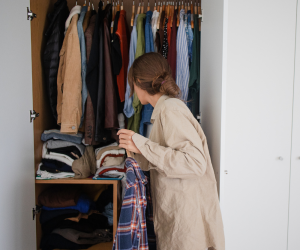What is stereotypy?
Stereotypy is a set of behaviours repeated excessively without purpose. It can be gestures or words, often associated with OCD or even Tourette’s syndrome. It can indeed be one of the symptoms of this type of illness, but most of us have had stereotypies 😳. In fact, this is a normal stage in a child’s development and most of the time the stereotypies disappear.
Nevertheless, sometimes repeated gestures or words remain, which corresponds to primary stereotypy. When symptoms appear at a different age, this is called secondary stereotypy. It can be caused by a whole range of factors.
👋 You may be interested in this article: What is separation anxiety?
The causes
It’s important to bear in mind all the causes of stereotypy, as this helps us to understand whether it’s primary or secondary 🧐. This behavioral disorder may be a symptom of another psychological disorder or illness, such as:
- Autistic disorder,
- Rett syndrome,
- Childhood disintegrative disorder,
- Asperger’s syndrome.
But that’s not all. It’s also related to forms of psychosis or schizophrenia. It may also reflect a frontal lobe deficiency or lesion. Finally, drugs, particularly cocaine, cause more severe stereotypic behavior.
The different stereotypies
We’ve talked about gestures and speech, but there are several stereotypies:
👉 Motor stereotypy: this includes all repeated movements such as body rocking or finger movements.
👉 Vocal stereotypy: this corresponds to the identical reproduction of sounds, vocalizations, words or phrases heard by someone close to them or by a source of sound (such as TV).
👉 Sensory stereotypy: this is manifested by the search for particular stimuli (textures, noise, light, etc.) on which the patient will focus for a long time.
👉 Object stereotypy: this involves the overuse of an object outside its initial function. The person will become attached to a particular object that they’ll carry around with them everywhere and touch constantly.
The symptoms
Knowing the different forms of stereotypy allows us to better understand and spot the symptoms. It’s important to remember that certain gestures or behaviors are normal for children and part of their development 👇:
- Thumb sucking,
- Tongue and nail-biting,
- Hair twirling,
- Head banging,
- Rocking back and forth,
- Rhythmic head nodding,
- Trembling hands,
- Curling feet,
- Waving hands,
- Twisting fingers,
- Arm flapping,
- etc.
Worth noting
A common sensory stereotypy in babies and young children is masturbation. It’s a form of self-stimulation to help understand how the body works and is part of a child’s development.
|
👋 You may be interested in this article: Why we need to stop comparing kids
Treatments for stereotypy
In the majority of cases of primary stereotypy, there are no psychological or physical repercussions. Most of the time they disappear on their own, as this concerns young children 👶. Unless it corresponds to a symptom of another disorder, such as autism. In that case, you first need to detect autism in the child, then seek out multidisciplinary support to prevent stereotypies from impairing social interaction.
We also try to reduce stereotypies when they’re secondary and appear at a later age. Here again, they can disrupt the personal and social life of the person suffering. A psychiatrist should therefore be consulted to look for other associated illnesses. Depending on the individual, a course of medication may be suggested, as well as cognitive behavioral therapy to control and reduce the stereotypies.
Editor’s note – Be alert to disturbancesYou now know what stereotypy is. If you notice that your child’s stereotypy is a long-term problem, coupled with other behaviors, it’s important to seek help. The same applies if it appears later and is unusual. If you’re an adult and this concerns you, don’t hesitate to contact an addiction service to assess the consequences of your consumption. In all cases, it’s important to talk about it if it’s disrupting the life of the child or the person concerned.
🤗 Understanding yourself, accepting yourself, being happy... It’s here and now!
#BornToBeMe
|
Be sure to check out these articles too;


















Did you like this article?
Want to know more 🤔 ?
Write directly to the authorLaurenHart !
Ask Lauren a question
Want to share your thoughts? Leave a comment